Communication and Collaboration between Humans and Objects and between Objects and Objects, Will Help Realize the Ideal Society of the Future
Communication and Collaboration between Humans and Objects and between Objects and Objects, Will Help Realize the Ideal Society of the Future
We asked Associate Professor Kazunori Takashio to describe the ideal society that will be brought about by the rich connectivity—of humans with objects, and of objects with objects—that he seeks in his ubiquitous computing research.
TAKASHIO, Kazunori
What Ubiquitous Computing Can Do for Society
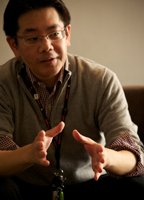 Sometimes, at a train station, when you’re about to pass through an automatic ticket gate using your train fare smart card, the device fails to read the information. The barrier slams shut and you feel as though you’re somehow in disgrace. It’s not your fault that the card didn’t scan, but when the gate snaps shut it makes you very conscious of everyone watching. That’s just one example of the many situations where the interface with a device or system dictates the user’s behavior. To improve these situations, we need computers that can adapt to human behavior; in other words, we need computer systems that can identify a person’s circumstances in a more precise, context-aware way, plus highly developed communication between people and computers (objects). The terms “ubiquitous computing” and “ubiquitous networking” refer to computer and network services being accessible to (or accessed by) anybody, anywhere, anytime, without conscious effort. In our ubiquitous research, we envision a world where computers (objects) give humans the assistance they need based on this kind of accurate grasp of their circumstances.
Sometimes, at a train station, when you’re about to pass through an automatic ticket gate using your train fare smart card, the device fails to read the information. The barrier slams shut and you feel as though you’re somehow in disgrace. It’s not your fault that the card didn’t scan, but when the gate snaps shut it makes you very conscious of everyone watching. That’s just one example of the many situations where the interface with a device or system dictates the user’s behavior. To improve these situations, we need computers that can adapt to human behavior; in other words, we need computer systems that can identify a person’s circumstances in a more precise, context-aware way, plus highly developed communication between people and computers (objects). The terms “ubiquitous computing” and “ubiquitous networking” refer to computer and network services being accessible to (or accessed by) anybody, anywhere, anytime, without conscious effort. In our ubiquitous research, we envision a world where computers (objects) give humans the assistance they need based on this kind of accurate grasp of their circumstances.
The Last Remaining Issue: Object-to-Object Communication and Collaboration
 The ultimate goal of ubiquitous computing research is to enrich communication in human society. We recognize three types of communication: human-to-human, human-to-object, and object-to-object. The human-to-human infrastructure has already reached a certain level due to the spread of the Internet, among other advances. And now we’ve made some headway at the next stage: research for richer connectivity between humans and objects. For example, if we have a person wear a sensor (an object), we can detect the information that they are walking, or sitting, or whatever they are doing, and if the room they are in has sensors installed at various points, we can obtain information about where they are sitting and what they are doing. At the next stage, when connectivity among objects becomes highly developed, it should be possible for objects to share information without human intervention, to predict what someone will do next based on the prior pattern of that person’s daily life, and to provide help accordingly. Major functions can be performed by tiny computers whose individual functions are not at all complex, once they are distributed and enabled to communicate among themselves. Of course, it is important that this be done seamlessly and unobtrusively.
The ultimate goal of ubiquitous computing research is to enrich communication in human society. We recognize three types of communication: human-to-human, human-to-object, and object-to-object. The human-to-human infrastructure has already reached a certain level due to the spread of the Internet, among other advances. And now we’ve made some headway at the next stage: research for richer connectivity between humans and objects. For example, if we have a person wear a sensor (an object), we can detect the information that they are walking, or sitting, or whatever they are doing, and if the room they are in has sensors installed at various points, we can obtain information about where they are sitting and what they are doing. At the next stage, when connectivity among objects becomes highly developed, it should be possible for objects to share information without human intervention, to predict what someone will do next based on the prior pattern of that person’s daily life, and to provide help accordingly. Major functions can be performed by tiny computers whose individual functions are not at all complex, once they are distributed and enabled to communicate among themselves. Of course, it is important that this be done seamlessly and unobtrusively.
The Next Step in Ubiquitous Computing Research
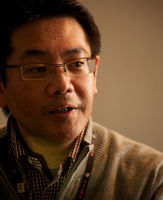 At present, sensor data and their patterns yield simple information, such as the fact that a person is walking or sitting. But take an action like walking: you can observe what the person is doing now, but what they’ll do next is highly mutable, depending on how they happen to feel at that moment. For example, if he’s in a good mood a pedestrian might say “Excuse me” when he bumps into somebody, but at this moment he’s in a bad mood and so he gets into an altercation. Present-day technology doesn’t allow us to take into account this mental factor—people’s moods—in predicting behavior patterns. And so I have started doing some research to obtain information on the mental factor. I’m still at the stage of basic experimentation, but in psychology there are advanced studies on inferring people’s emotional state from signs like changes in heart rate, and in my work I am seeking to prove these inferences in real time using medical biosensors that monitor heart rate, skin temperature, and so on.
At present, sensor data and their patterns yield simple information, such as the fact that a person is walking or sitting. But take an action like walking: you can observe what the person is doing now, but what they’ll do next is highly mutable, depending on how they happen to feel at that moment. For example, if he’s in a good mood a pedestrian might say “Excuse me” when he bumps into somebody, but at this moment he’s in a bad mood and so he gets into an altercation. Present-day technology doesn’t allow us to take into account this mental factor—people’s moods—in predicting behavior patterns. And so I have started doing some research to obtain information on the mental factor. I’m still at the stage of basic experimentation, but in psychology there are advanced studies on inferring people’s emotional state from signs like changes in heart rate, and in my work I am seeking to prove these inferences in real time using medical biosensors that monitor heart rate, skin temperature, and so on.
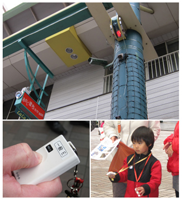 Until now, ubiquitous computing has tended to be associated with the “anybody, anywhere, anytime” model. What we foresee next is an “only for me, only here, only now” model, i.e., providing specific services to specific people at specific times and places. As a concrete example, let’s take a system for monitoring children’s safety. Children’s behavior patterns show that when their attention focuses on one thing, they’re heedless of their surroundings. Say a girl is waiting at the traffic lights and someone across the street calls to her, she is liable to disregard the red light and dash into traffic. If there were a computer system in the city streets that grasped this tendency of children, monitored their environs, and provided assistance the moment it was needed, it could perhaps prevent an accident in this case by changing the timing of the signals. In an experiment we did in the shopping district of the City of Akabane, in Tokyo, we ran an actual child monitoring service after installing ubiquitous network infrastructure in the streetlights when they were converted to LED lamps.
Until now, ubiquitous computing has tended to be associated with the “anybody, anywhere, anytime” model. What we foresee next is an “only for me, only here, only now” model, i.e., providing specific services to specific people at specific times and places. As a concrete example, let’s take a system for monitoring children’s safety. Children’s behavior patterns show that when their attention focuses on one thing, they’re heedless of their surroundings. Say a girl is waiting at the traffic lights and someone across the street calls to her, she is liable to disregard the red light and dash into traffic. If there were a computer system in the city streets that grasped this tendency of children, monitored their environs, and provided assistance the moment it was needed, it could perhaps prevent an accident in this case by changing the timing of the signals. In an experiment we did in the shopping district of the City of Akabane, in Tokyo, we ran an actual child monitoring service after installing ubiquitous network infrastructure in the streetlights when they were converted to LED lamps.
Looking Five and Ten Years into the Future
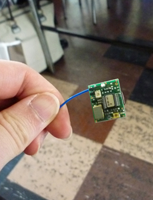 I expect the “smart town” concept, with small computers embedded in the city landscape, will eventually be realized everywhere. Picture the Shonan Fujisawa Campus (SFC) five years from now: I imagine a whole infrastructure of sensors and small computers distributed all over campus, so that a student can use a smart phone or similar object to pluck information that meets his or her particular needs at any given moment. Then, if we picture society ten years from now, objects themselves may have become context-aware and they may have taken on identities. There may be tiny, rice-grain-sized computers with these capabilities embedded all over our cities, ready to provide support for human actions when the objects themselves judge it necessary. Moreover, the range of human perception may have been vastly extended by the development of sensors corresponding to our five senses and relay systems that convey the information they gather to remote locations as required. For example, a student on campus might be able to physically sense what is going on in his or her apartment. Enlarging our range of perception in these ways could even change human beings themselves; it could have a great impact on our sense of values.
I expect the “smart town” concept, with small computers embedded in the city landscape, will eventually be realized everywhere. Picture the Shonan Fujisawa Campus (SFC) five years from now: I imagine a whole infrastructure of sensors and small computers distributed all over campus, so that a student can use a smart phone or similar object to pluck information that meets his or her particular needs at any given moment. Then, if we picture society ten years from now, objects themselves may have become context-aware and they may have taken on identities. There may be tiny, rice-grain-sized computers with these capabilities embedded all over our cities, ready to provide support for human actions when the objects themselves judge it necessary. Moreover, the range of human perception may have been vastly extended by the development of sensors corresponding to our five senses and relay systems that convey the information they gather to remote locations as required. For example, a student on campus might be able to physically sense what is going on in his or her apartment. Enlarging our range of perception in these ways could even change human beings themselves; it could have a great impact on our sense of values.
100 Percent Tailored to Personal Specifications
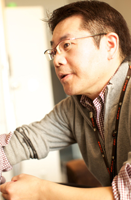 SFC is often said to offer a very favorable research environment, and I have certainly found this to be so. For example, as I mentioned, I am exploring ways of obtaining information on the mental factor in human behavior patterns, although, as a subject, this is outside my specialty. However, thanks to having colleagues in a wide array of fields here at SFC, I can seek their advice and collaboration. Again, in the experiment where we put computers in streetlights, I don’t have the background to look at the economic effects of the project, such as whether it has helped revitalize the shopping district, but I could work with an expert in that area. The possibility of such collaborations materializing right here on campus is a big advantage for the students, too. Also, having the opportunity to study a wide range of academic fields in such an interdisciplinary way means that they should be able to get what they really want from their studies. I would like them, during their time at SFC, to do some research that is 100 percent tailored to their own personal specifications. When they go out into the working world, they will inevitably have to make things whose specifications are the greatest common denominator, because they are to be used by many people. But while at university the students have a chance to create something to their own specifications, without compromises, and I hope they’ll make the most of it.
SFC is often said to offer a very favorable research environment, and I have certainly found this to be so. For example, as I mentioned, I am exploring ways of obtaining information on the mental factor in human behavior patterns, although, as a subject, this is outside my specialty. However, thanks to having colleagues in a wide array of fields here at SFC, I can seek their advice and collaboration. Again, in the experiment where we put computers in streetlights, I don’t have the background to look at the economic effects of the project, such as whether it has helped revitalize the shopping district, but I could work with an expert in that area. The possibility of such collaborations materializing right here on campus is a big advantage for the students, too. Also, having the opportunity to study a wide range of academic fields in such an interdisciplinary way means that they should be able to get what they really want from their studies. I would like them, during their time at SFC, to do some research that is 100 percent tailored to their own personal specifications. When they go out into the working world, they will inevitably have to make things whose specifications are the greatest common denominator, because they are to be used by many people. But while at university the students have a chance to create something to their own specifications, without compromises, and I hope they’ll make the most of it.
A Brief Background of Associate Professor
TAKASHIO, Kazunori
Associate Professor Takashio received his bachelor’s degree in 1990 from the Faculty of Science and Technology, Keio University. He earned his PhD in computer science from Keio University in 1995. After serving as an assistant in the Department of Computer Science, Faculty of Electro-Communications, University of Electro-Communications, and then as a Special Research Associate Professor in the Graduate School of Media and Governance at Keio University, he became Associate Professor at the Faculty of Environment and Information Studies in 2005. He specializes in distributed and real-time systems and in mobile and ubiquitous computing. He has taken part in numerous research projects, including the 2002–2005 project titled Research on Ubiquitous Information Society Based on Collaboration among Humanity and Engineering Disciplines, sponsored by the Promotion of Advanced Research Program of the Special Coordination Funds for Promoting Science and Technology of the Ministry of Education, Culture, Sports, Science and Technology (MEXT). Since 2006, he has been a member of Overlay-network Search Oriented for Information about Town Events (OSOITE), an Advanced Integrated Sensing Technology Project that forms part of the Core Research for Evolutional Science and Technology (CREST) of the Japan Science and Technology Agency (JST).
(06 September 2011)
Archive